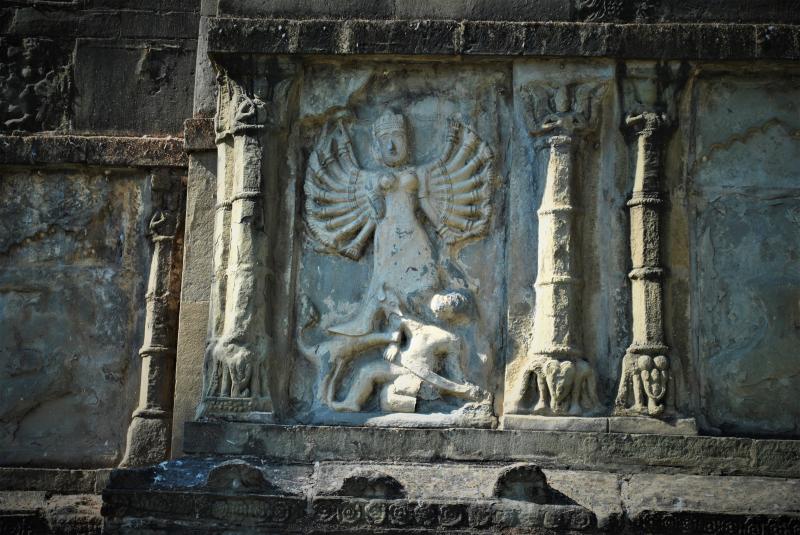The Ahoms are believed to have migrated from the Yunnan province of China whereas there’s another school of thought which believe that they have migrated from upper Burma, which is present-day Myanmar. Scholars assert that the Ahoms were a section of Thais and entered the Brahmaputra valley from the southeastern side called the Patkai hills. The first ruler and the founder of the Ahom dynasty was Chau-lung Siu-ka-pha, known as the architect of Assam. He established the capital of the Ahom kingdom at Che-rai-doi in 1253 AD. The word Che-rai-doi means ‘the shining city on the hills’. At its peak, the Ahom kingdom was stretched from Sadiya in the east to Guwahati in the west. However, they slowly occupied the whole Brahmaputra valley and ruled till mid of the 19th century.

Sukapha as a ruler was of benevolent personality. He never wanted to force or impose his authority directly upon the local inhabitants of the areas. Instead, he moved and lived amongst the tribesmen. Not only he learnt their languages and honored their rites he also established marital relations with their daughters and lived a simple life like a commoner. It is even said that Sukapha accepted the locals as his own men and placed them on equal footing. The Hinduisation of the Ahoms was not so sudden. It can be interpreted that the steps undertaken by Sukapha to assimilate with the local people of the areas were probably one of the first instances of their Hinduisation process. Although historians argue that the first Ahom king under whom the actual process of this conversion happened was Sudangpha (1397-1407 AD), who was popularly known as Bamuni Konwar (Brahmin Prince). Interestingly Prince Sudangpha was born and raised in a Brahmin family, which is another different story to tell. However, after becoming the king of the Ahom throne as a gratitude to his foster family he brought them to the royal court and even started giving positions to the Brahmin relatives as high officials. It is said that the Brahmana father of Sudangpha first introduced the worship of the god Vishnu at the Palace. Sudangpha was also the first king who performed a coronation ceremony called the ‘singari-ghar’ following both Ahom and Hindu rites and rituals. Historians also argue that the king was so much influenced by Hinduism that he assumed Hindu titles like Maharaja and so on. After Sudangpha, Suhungmung became the next ruler of the Ahom kingdom. Suhungmung’s reign witnessed a considerable rise in Hindu influence in the court. The Swargdeo title which was a Hindu title became the official title of the Ahom kings and was first adapted under Suhungmung’s rule. He even introduced the Saka era in place of the Ahom system. Another important development under Suhungmung was the writing of Buranjis which are Ahom Chronicles where for the first time the Brahmanical origin of the Ahoms kings was constructed. Suhungmung’s successor Suklenmung continued with the same trends as he installed the Ahom deity of Chomedeo in a separate temple just because he did not want to have both the Ahom and Hindu deity representing two different faiths in one place.
By the time of the next ruler Sukampha, there was a tremendous spread of Neo Vaishnavism and the establishment of satras in many parts of Assam on a large scale. Satras are religious institutions established during Sukampha’s reign. Thus both the process of Brahmanism and Vaishnavism ran parallel at the Ahom court. The most important thing that happened during this period was the beginning of the worship of the goddess Durga. Now the Brahman priests started becoming strong power holders with their influence tremendously increasing. Under the ruler Susengpha, many Siva temples were built in many parts of the Ahom kingdom. He even gave preferences to Brahmin messengers instead of Ahom messengers. Historians have argued that it was during Susengpha’s reign that royal land grants such as Debottar and Dharmottar were introduced. These were land grants initiated for the maintenance of the temples and priests. The most important development of this Hinduisation process happened by the time when the king Susengpha adopted a Hindu name, Pratap Singha and this was the first time that an Ahom ruler adopted any such Hindu name along with his Ahom name. However, during the rule of Gadadhar Singha, he became apprehensive at the growing power and popularity of the Vaishnava satras whom he saw as a threat to the power and integrity of the Ahom kingdom, and thus followed a policy of Vaishnava persecution.’ In this process, various Vaishnava satras were destroyed and their heads were killed. One interesting thing to note here is that king Gadadhar Singha was a patron of the ‘Shakta cult’. Now the actual clash between the king’s religion and the people’s religion came into conflict. It is believed that the process of Hinduisation of the Ahom court reached its climax during the Ahom queen Phuleswari who was made bor raja or the chief king. Bor raja Phuleswari had a blind faith in the Shakta cult and wanted to convert the whole population into it forcefully. One instance during her reign was at the time of the Durga puja celebration when she ordered to apply tikas of the blood of sacrificed animals on the Vaishnava mahantas forehead. This event angered the Vaishnava gurus and eventually became one of the main reasons for the Moamariaya rebellion against the throne. One important thing to note here is that the Moamariaya rebellion also can be considered as one of the very first oppositions against the Ahom throne.

The Hinduisation of the Ahoms was not an overnight process. It was a process spanning many years of acceptance, practices, and the urge to assimilate into a single culture. Moreover, it cannot be overlooked that this was one among their many political ideologies to gain popularity, power, and strength in this new and alien territory. No doubt this conversion led to significant changes in the lives of Ahoms both culturally, politically, and also in their lifestyle practices. But one thing which cannot be ignored is if the Ahom rulers did not convert to Hinduism perhaps the 600 years of their rule wouldn’t have been possible.

Bibliography
Baruah Chandan; Hinduisation of the Ahom court in the medieval Assam, Indian History Congress, New Delhi, 2004, https://www.jstor.org/stable/44144751

Jikmik Molia
Jikmik Molia is a final year student of History at Sri Venkateswara College, Delhi University. Interested in exploring ancient Indian history and the history and culture of North East India, she aspires to pursue Archaeology at a near future.


Excellent post. I certainly appreciate this website. Keep writing!
Excellent post. I was checking constantly this blog and I am impressed! Extremely useful information specially the last part 🙂 I care for such information much. I was looking for this particular info for a very long time. Thank you and best of luck.
You really make it seem so easy with your presentation but I to find this topic to be actually something which I feel I might by no means understand. It seems too complex and very extensive for me. I am having a look forward on your subsequent post, I?¦ll try to get the cling of it!
Can I simply say what a relief to find someone who truly knows what theyre talking about on the internet. You definitely know easy methods to convey a difficulty to mild and make it important. More folks have to learn this and perceive this aspect of the story. I cant consider youre not more common because you undoubtedly have the gift.
Really good visual appeal on this site, I’d rate it 10 10.
Great weblog right here! Also your web site a lot up fast! What host are you the use of? Can I am getting your associate link in your host? I wish my site loaded up as quickly as yours lol